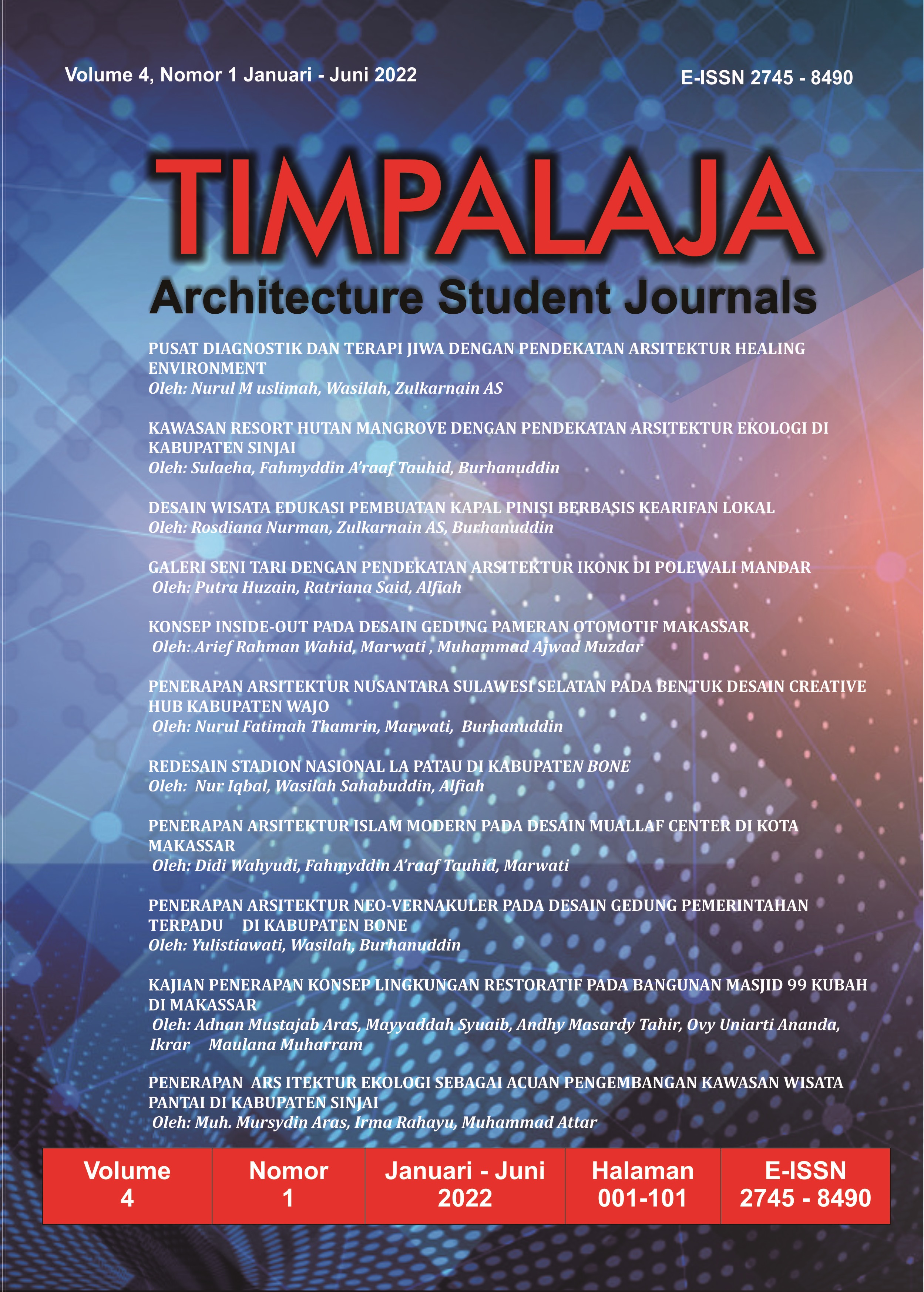Kajian Penerapan Konsep Lingkungan Restoratif pada Bangunan Masjid 99 Kubah di Makassar
Abstract
This study aims to determine the object of research applying the criteria as a restorative environment. The object of this study is the 99-domes mosque located in the central Point of Indonesia (CPI) Tanjung Bunga Makassar. The method used is descriptive analysis method, which is by collecting data and comparative studies and then analyzed and concluded. In collecting data, conducted several ways such as literature studies to obtain relevant data and references, then interviews, as well as field observations to directly feel the atmosphere of the object to be discussed. The results showed that the existence of this mosque can give the community a restorative experience. The experience of calm and peace from to these criteria has managed to restore the physical and psychological condition of the people. It can be said that visitors regain their energy and motivation to undergo the next activity.
References
Daniel, R. M. (2014). The Effects of the Natural Environment on Attention Restoration. Appalachian State University, Boone, NC.
Hartig, T. (2004). Restorative Environments (C. D. Spielberger, E. of A. Psychology, & Elsevier (ed.)). https://doi.org/10.1016/B0-12-657410-3/00821-7
Hartig, T., Kaiser, F., & Bowler, P. (1997). Further Development of a Measure of Perceived Environmental Restorativeness (Working Paper #5).
Kaplan, R., Kaplan, S., Brown, T. (1989). Environmental Preference: A Comparison of Four Domains of Predictors. Environment and Behavior. https://doi.org/10.1177/0013916589215001
Kaplan, S. (1995). The restorative benefits of nature: Toward an integrative framework. Journal of Environmental Psychology, 15(3), 169–182. https://doi.org/10.1016/0272-4944(95)90001-2
Korpela, K., & Hartig, T. (1996). RESTORATIVE QUALITIES OF FAVORITE PLACES. Journal of Environmental Psychology, 16(3), 221–233. https://doi.org/10.1006/JEVP.1996.0018
Ni Luh Desi In Diana Sari. (2007). warna.
Pasini, M., Berto, R., Scopelliti, M., & Carrus, G. (2009). Measuring the restorative value of the environment: Contribution to the validation of the Italian version of the perceived restorativeness scale. Boll. Psicol. Appl., 257, 3–11.
Pratiwi, T. N., Brawijaya, U., Administrasi, F. I., Publik, J. A., Studi, P., & Administrasi, I. (2018). Terhadap Urban Stress Masyarakat.
Setyawan, J., Jannah, M., & Syafiq, M. (2017). Mengalami Masjid Sebagai Lingkungan Restoratif Experiencing A Mosque as A Restorative Environment Jefri Setyawan, Miftakhul Jannah, Muhammad Syafiq Program Studi Psikologi Universitas Negeri Surabaya. 8(1), 68–78. https://www.google.com/url?sa=t&rct=j&q=&esrc=s&source=web&cd=&cad=rja&uact=8&ved=2ahUKEwirx6HM8tnsAhUDfisKHaptAAEQFjABegQIAxAC&url=https%3A%2F%2Fjournal.unesa.ac.id%2Findex.php%2Fjptt%2Farticle%2Fdownload%2F1677%2F1115&usg=AOvVaw3bly91kKqsJKmIuU6BxQmv
Copyright (c) 2022 Adnan Mustajab Aras, Mayyadah Syuaib, Andhy Masardy Tahir , Ovy Uniarti Ananda, Ikrar Maulana Muharram

This work is licensed under a Creative Commons Attribution-ShareAlike 4.0 International License.
By submitting your manuscript to our journal, you are following Copyright and License







